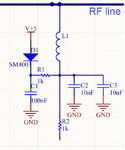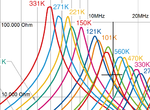carpenter
Full Member level 6
For example in coaxial line is high power AC 15MHz 200Vrms and we need add in this line small DC current 10mA,
I thing we use inductor with high impedance for AC and small for DC
For exemple NLC453232T-560K-PF
In graph on page 7 I choice inductor with max real induktance on 15MHz 560k 56uH with 80uH on 15MHz
In next step I look on page 9 impedance on 15MHz for 560k is any about 50k Ohm and 2,2 Ohm for DC.
Is it the right choice?
The coil has SRF 11MHz will not this problem?
How is it with voltage resistance?
Thanks
I thing we use inductor with high impedance for AC and small for DC
For exemple NLC453232T-560K-PF
In graph on page 7 I choice inductor with max real induktance on 15MHz 560k 56uH with 80uH on 15MHz
In next step I look on page 9 impedance on 15MHz for 560k is any about 50k Ohm and 2,2 Ohm for DC.
Is it the right choice?
The coil has SRF 11MHz will not this problem?
How is it with voltage resistance?
Thanks

